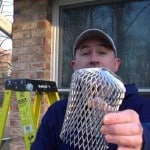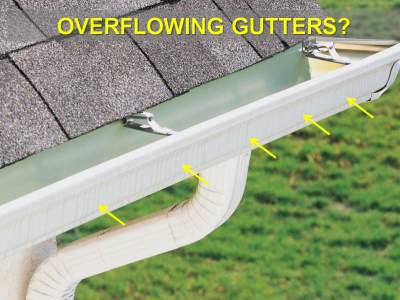Since we in Cincinnati have to consider severe weather, we’d like to highlight 3 home maintenance tips that are essential this spring in order to protect your property against impending water leaks and energy losses. By tackling these 3 minor maintenance items before the rainy season comes, you can save yourself a ton of money and preserve the value of your home.
SPRING HOME MAINTENANCE TIP #1 – GUTTERS
We have talked before about the importance of gutter cleaning to ensure that excess water does not build up in your gutters and threaten to overflow or pull the gutters from your house. Overflowing water can cause serious leaks which allow water to get into your roof boards and cause rot and mold, while a gutter pulled from your house is obviously quite severe. But beyond cleaning your gutters every spring, you should also consider installing a downspout screen or gutter guard which both serve to trap leaves before they make it into your gutters and downspouts, thus reducing the required cleaning. So, with clean gutters and measures taken to keep them clean, the next home maintenance item would be to ensure that the gutters are working properly.
Ensure Gutter Flow and Home Structural Integrity
The whole point of a downspout is to carry water away from your foundation because water near the foundation can cause serious water leaks and long-term damage. If the downspout is emptying close to your house then you should consider adding extensions which will carry that water further away. Adding an extension is a cheap and easy DIY project and can come in many forms depending on what material you want to use, how much you want to hide or expose the extension, and the layout of your home and yard. That is a long conversation, but if you decide to add extensions, it is easily done with the right resources.
SPRING HOME MAINTENANCE TIP #2 – WATERPROOFING EXTERIORS AND ELECTRICAL
Check and Seal Exterior Electrical and Other Fixtures

Sealing Exterior Fixtures
Exterior electrical units like lights, outlets, switches, etc. and other fixtures such as windows or doors should be checked to make sure that they are sealed well from water intrusion. In order to do that:
- You should make sure that any sealant or caulk that was around these units has not weathered away in the winter.
- If any minor damage has occurred, then with a silicone caulking and a caulk gun you can at least repair minor damages and add a layer around the outside of these fixtures as a preventative home maintenance measure. This will help ensure that water cannot leak in behind these fixtures and cause serious problems.
- If you think there already is a problem such as water intrusion or damage, you can be certain by looking for the telltale signs that indicate leaking windows.
If there are leaks or issues already, you may be in trouble and admittedly a bead of caulk won’t help this; but a simple DIY seal job can go a long way as a preventative measure.
Also, you should make sure that all of your exterior electrical outlets (and even interior ones with the chance of coming in contact with water) have a ground fault circuit interrupt (or GFCI/GFI) which may not be the case for older homes. These are the outlets with the typically red and black buttons in the middle with “test” and “reset” that ensure that if by some accident electricity tries to run through you to get to the ground, the circuit will shut off. If these need to be installed, it is possible for the DIYer that has some electrical experience, but we suggest leaving this one to a professional.
SPRING HOME MAINTENANCE TIP #3 – INCREASED INSULATION
Increase the Energy Efficiency of Your Home with Added Attic Insulation
Often people think that they lose the most money due to energy inefficiencies in the winter with drafty doors and windows. But the cool air from air-conditioners in your home during the spring and summer months can just as easily leave through poor insulation in your attic which can cost you. To begin, we always suggest an energy audit to figure out how you can prevent the money from flowing out of your house.
For those looking for a DIY project to increase home energy efficiencies this spring, one easy DIY tip is to add some additional insulation in your attic. Adding insulation to your attic is easily done especially for the old pink fiberglass batting that we are all used to. The discussion about the many other types of insulation, their specifications, and how they are installed is a topic for another time. If your Cincinnati attic only has about 6 inches of pink batting, then this will not suffice in keeping your home insulated. These insulation sheets are rated by their R-Value which is their resistance to heat transfer: a higher value = more insulated. 6 inches of the pink fiberglass insulation has an R-Value of only about 19 when really at least twice that is recommended (38+). So again, other types of insulation like spray applications should be left to the professionals. But if you’re installing additional pink fiberglass in fluffy panels, the process is easy:
- Be prepared with gloves, goggles, and respirator masks: these sheets are made of glass.
- When adding to existing insulation, you will want to buy un-faced/uncovered sheets (sheets without paper or vinyl casings of any sort on them, completely naked).
- Lay the new sheets on top of and perpendicular to existing sheets and covering wood floor beams. This will ensure that heat transfer through the wood will be limited.
- DO NOT pack the insulation under the ceiling rafters as they come down to the floor, leave some room at each end as airflow is very important for the integrity of the roof.
- We advise about 12″ or more of the fiberglass insulation for your attic.
Get out there DIYers! Some simple little home maintenance tips right now can go a long way to prevent water leaks from your gutters, windows, or fixtures and can help you save money on energy savings. Let us know in the comments or on Facebook with any questions or give us a call: (513)-724-0539.






Speak Your Mind